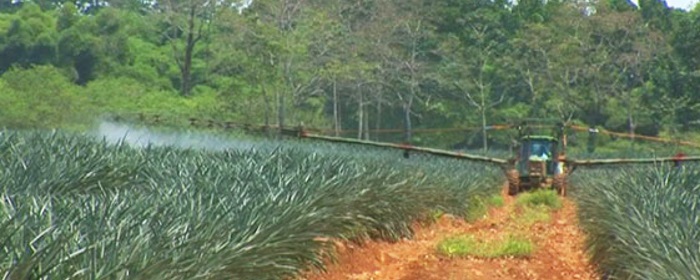Due to the peculiarity of the fruit and its production cycle, which is falsely accelerated, approximately 60 per cent from every tonne of chemicals used in the cultivation of pineapples goes directly into the environment.[1] This is of primary concern to the communities of Cairo, La France, Milano and others in the Siquirres district of north-eastern Costa Rica. In 2007, the agrochemicals Bromacil (associated with thyroid, liver and kidney cancer), Diluron and Tridamefón (also known to be carcinogenic and prone to induce chromosome abnormalities) were detected in water sources here.[2] Despite article 31 of Costa Rica’s Water Act requiring a protection perimeter of no less than 200m in radius, pineapple crops are less than 20 meters from water sources in some of these areas.[3] Rashes on the skin are now commonplace, and an increase in asthma and miscarriages have been recognised.[4]

Another example of environmental contamination as a result of pineapple production comes from Del Monte’s ‘Babylonia’ farm on the Caribbean coast. Studies have found evidence of the carcinogenic herbicides Bromacil and Diaron being prominent in the water source, thereby rendering it unfit for consumption. For the last 3 years pineapple workers have been fighting this case. The government’s only response is to bring in tanks of potable water at a cost of US$27,000 a month. A new reservoir would cost US$80million.[5]
The journal Surcos claims that some 6,000 people in the Atlantic zone are affected by this contamination and that the Costa Rican Water and Sanitation Institute’s water tests “confirm the presence in domestic water of toxic agro-chemicals used on the pineapple plantations”.[6]
The Biodiversity Act article 109 establishes that the alleged polluter is the one who must prove they are not responsible for the damage caused; but this case remains unresolved due to controversy over the law regarding the tolerable limits of such agrochemicals in potable water.
[1] Omar Alvarado Salazar, July 2008, Pineapple production in Costa Rica. FRENASAPP, www.detrasdelapina.org.
[2] Gabriela Square, September 2008, Legalisation of pollution of water for human consumption (the case of Diuron and Bromacil). FRENASAPP, www.detrasdelapina.org.
[3] Ibid.
[4] Alex Leff (April 2009) ‘Costa Rica’s pineapple country is no piña colada’, Global Post: Inside Costa Rica, www.insidecostarica.com/dailynews
[5] Didier Leiton Valverde of SITRAP, presentation to Environmental Network for Central America (ENCA), 17/06/10, London.
[6] Surcos (July 2010) ‘Comunidades y FRENASAPP luchan contra piñeras y demandan a empresa Del Monte’, Surcos 32, Costa Rica.